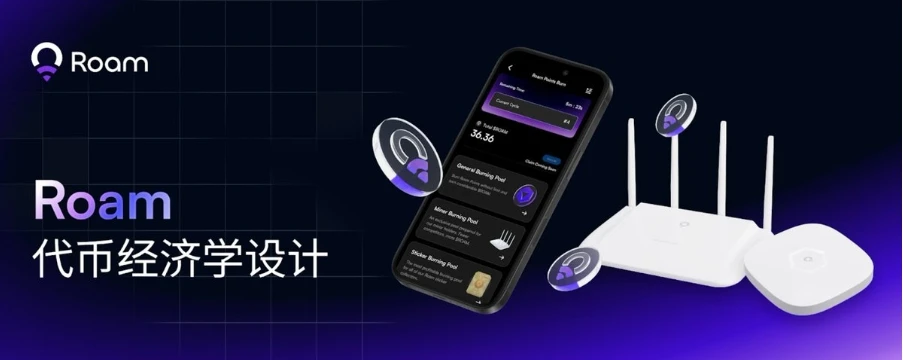
Today, Roam co-founder YZ published the latest Roam token economic design through his personal X account. This is a discussion draft that analyzes Roam's design philosophy and future development direction. Roam's token economics aims to promote the expansion and sustainable growth of global wireless networks by introducing a unique flywheel model. In the context of globalization, Roam's economic system not only addresses the pain points of the traditional telecommunications industry but also provides innovative solutions for the construction of the Web3 ecosystem. Below is the original content:
Over the past three years, @weRoamxyz @weRoamCN has undergone a transformation from #MetaBlox to #Roam. Along the way, although we have taken many detours, we are still grateful for the support of the community and the recognition from industry peers. Many people believe that Roam is a project with hardcore technology and real application scenarios. At least with Roam, we no longer have to worry about network issues during business trips. We sincerely thank the 2 million users for their love of our products.
Recently, Roam is about to complete the testing of the pre-burn pool and enter the airdrop and TGE official burn phase. At this critical moment, I would like to share the design of Roam's economic system. In my opinion, this is one of the most important tasks I have focused on over the past three years. In the current context where VC coins lack support and Meme PVP has left industry insiders feeling desperate, I hope everyone can discuss together to see if Roam's economic system has reference value and to find areas for improvement.
Before introducing the economic system, let’s briefly talk about our business model: Roam's business model is an open global wireless network, focusing on building networks through DePIN, connecting you, me, and others. Its core lies in operating communication services with an internet mindset, promoting ecological development and user base expansion through the Web3 flywheel effect, and breaking down data barriers through an open network to embrace the AI era.
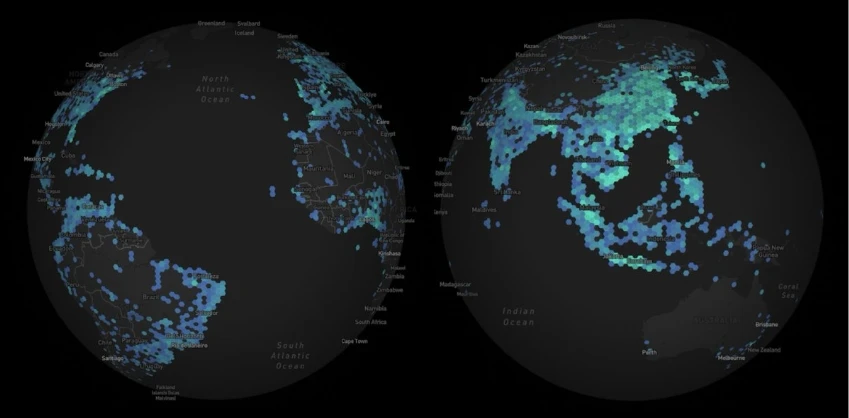
Currently, our business model has achieved dual-wheel drive, and in the future, it will achieve triple-wheel drive:
1.0 Roam's Economic Flywheel Model
Roam's economic system achieves sustainable development and growth through three key flywheels: the user flywheel, the node flywheel, and the future AI data flywheel.
User Flywheel:
Attract users through Web3 incentives.
Initially provide WiFi OpenRoaming services through a mobile app to expand the user base.
Further expand the user base through Web3 operations.
After reaching critical mass, reduce eSIM data costs and increase advertising and traffic revenue.
Achieve dual-track customer acquisition through WiFi OpenRoaming and global smart eSIM while maintaining positive cash flow.
As the user base expands, the token value enhances Web3 incentive effects, further reducing costs, returning to step 3.
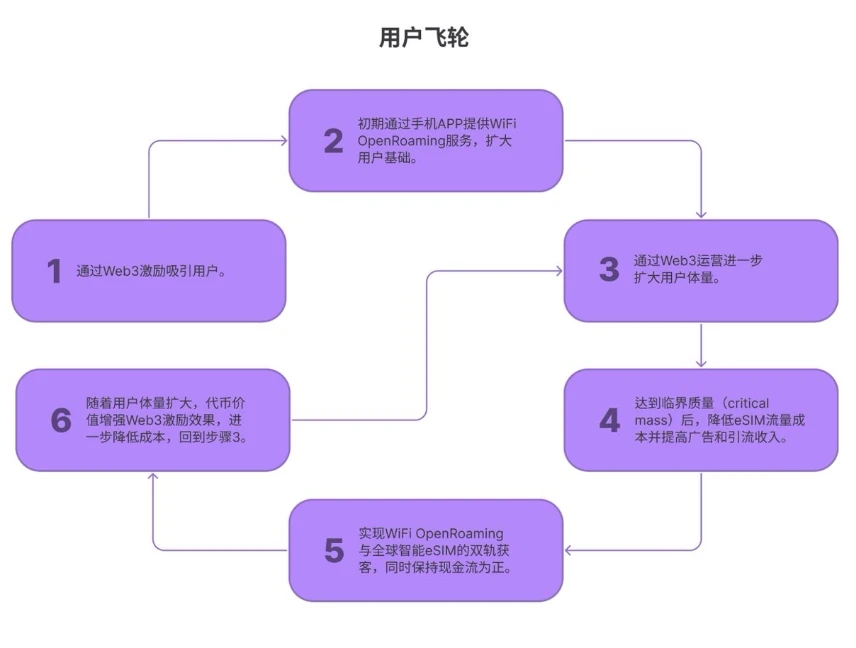
Node Flywheel:
Sell WiFi mining machines or upgrade community WiFi through Web3 incentives.
Provide broader network coverage and enhance user satisfaction.
Help the user flywheel increase the number of users, bringing more passive income to miners as more users check in.
Once the number of mining machines reaches critical mass, CDN and IP application customers will start to enter.
The Roam Growth program rewards miners with cash returns and launches a mining machine loan program.
Promote node expansion and improve B-end user experience, returning to step 2.
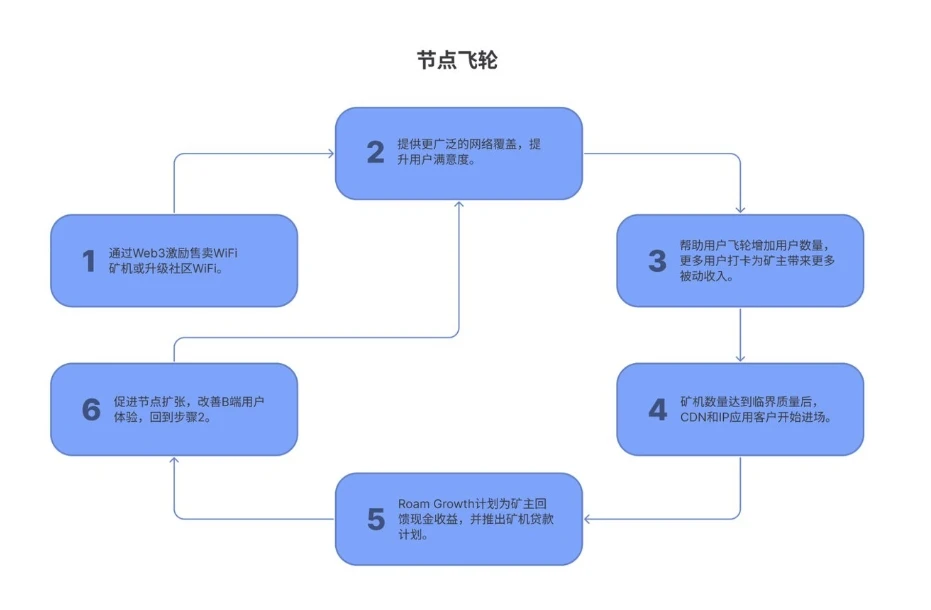
Future AI Data Flywheel:
Web3 incentives generate a large amount of DID-tagged location and time data with privacy protection.
The Roam Discovery program brings more ecological project data.
A large number of WiFi smart devices adopt DID-based OpenRoaming networking.
Support AI agents or AI avatars to utilize these devices.
Edge AI computing power and distributed models supported by nodes.
AI provides services through the Roam App and smart devices.
Further generate new data and expand new nodes, returning to steps 1 and 3.
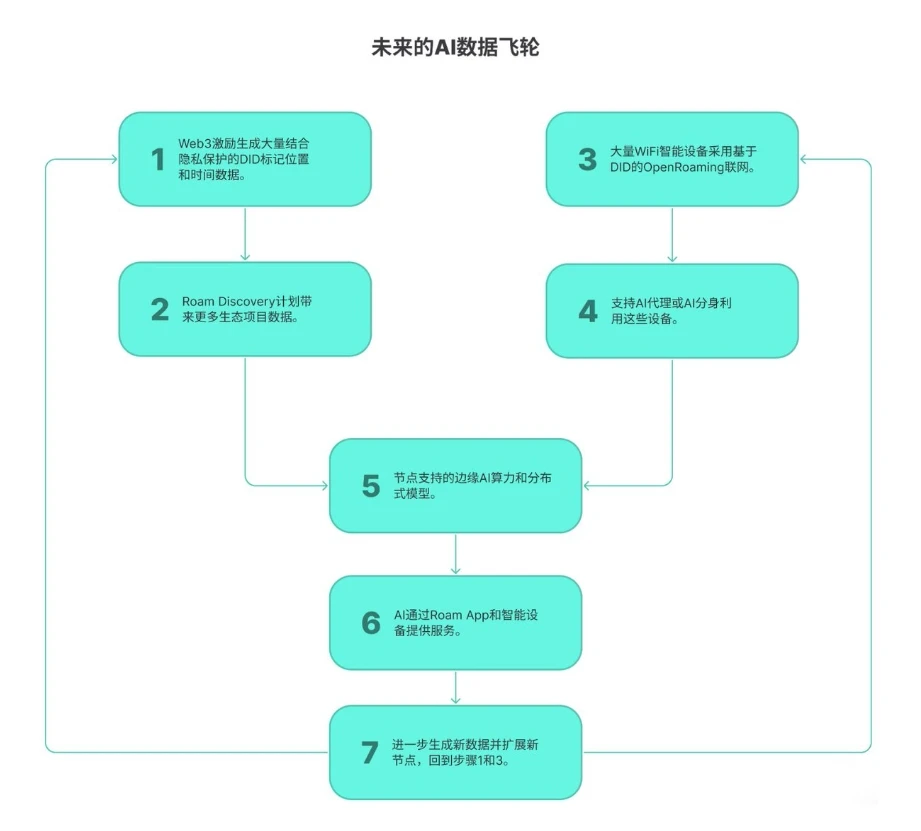
Through these flywheel models, Roam is committed to creating a sustainable ecosystem that promotes innovation and development in global wireless networks.
2.0 Analysis of Roam Token Economics
2.1 Token Distribution:
The total supply is 1 billion (1B) $ROAM tokens.
120 million (120M) are reserved for the team, distributed over 6 years.
280 million (280M) are allocated to past and future investors, with airdrops also deducted from this amount.
The remaining 600 million (600M) are generated through mining.
2.2 Design Principles:
Drawing on the so-called impossible triangle principle, Roam's token economics design fixes only two basic parameters while leaving everything else to the market to ensure the sustainable development of the system and maintain market stability.
Points:
The system uses points for settlement instead of directly using tokens. Points circulate only within the system, similar to Tencent Q coins or airline miles, with a constant value and no upper limit. Ecological sellers earn points when providing services, not tokens, to avoid selling pressure caused by token price increases and maintain reasonable pricing.
The fixed value of points is the first basic anchoring parameter.
Tokens:
The release curve of tokens is similar to Bitcoin's exponential decay. Initially, about 0.6% is released monthly, decreasing to 0.35% after 5 years, 0.2% after 10 years, 0.05% after 20 years, and 0.001% after 50 years.
The pre-fixed release curve is the second basic anchoring parameter.
2.3 Core Mechanisms:
Conversion between Points and Tokens:
Points are converted to tokens through a "burning" process, with the conversion ratio determined by the market.
Tokens can also be converted to points, which similarly involves token destruction.
Cycle Mechanism:
- The conversion process is based on Cycles (virtual blocks), with each Cycle lasting 1000 seconds.
Difficulty Adjustment Mechanism:
In homage to Bitcoin, Roam's token generation also has a difficulty adjustment mechanism.
The token release curve is adjusted based on network activity (number of check-ins) to ensure token value stability and avoid death spirals.
When network activity declines, the token release speed is adjusted to ensure token value. This process helps eliminate low-value nodes and enhance the earnings of high-value nodes, similar to the computing power upgrades in Bitcoin mining.
Mining and TGE:
Roam's TGE marks the official start of the conversion between points and tokens. Mining will consistently generate the same points before and after TGE.
Through these mechanisms, Roam is committed to establishing a stable and sustainable economic ecosystem to support the long-term development of its global wireless network.
2.4 Reward Mechanism
2.4.1 Points Generation
Roam's economic system centers on rewarding participants who contribute to the three core flywheels (user flywheel, node flywheel, AI data flywheel).
Mining machine holders are an important part of this system, earning daily points rewards. As the system develops, this reward method will gradually transition from the current uniform distribution to a differentiated distribution based on the service capabilities provided by the mining machines (such as CDN, IP-based services, etc.), further ensuring that rewards come from real cash flow. Additionally, mining machines can generate a small number of high-tier stickers daily, which miners can choose to give to other users or keep for themselves.
Community validators, i.e., app users, earn points rewards by verifying the operation of mining machines. They need to connect to the mining machines and perform network verification, "checking in." After each check-in, both the validators and mining machine holders receive corresponding points and stickers. This check-in process is a core behavior supporting the development of the three flywheels.
For the future AI data flywheel, Roam plans to launch an incentive mechanism similar to points generation in the second half of 2025.
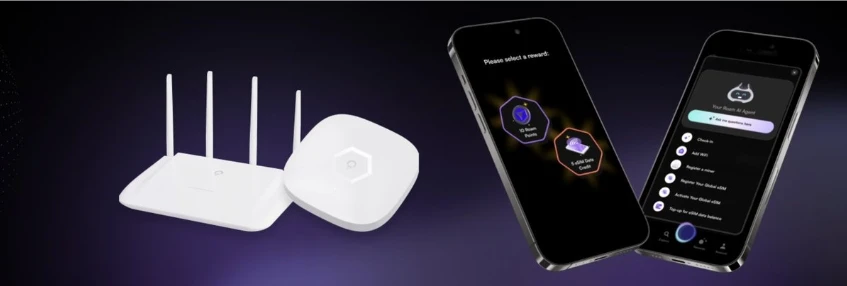
In addition to the above three points, Roam also encourages community users to add WiFi networks from third-party devices, especially those compatible with OpenRoaming. These users can earn point rewards similar to those from mining machines, but the reward amounts are relatively small. Both the validators who check in on these devices and the device registrants will receive rewards. In Roam's ecological projects, such as blockchain games, users have the opportunity to earn additional point rewards through participation, which also increases the system's playability. However, Roam and its Discovery ecological projects are designed not to change the overall quantity of points to ensure system stability.
2.4.2 Analysis
Overall, Roam's reward system is designed to encourage genuine labor and contribution. Users can earn considerable passive income by adding more mining machines or actively participating in activities. Many users have earned passive income after their initial registration by adding community WiFi and helping with its OpenRoaming upgrades. Top players can earn tens of thousands of points daily, translating into substantial income, enough for many to lead a happy life.
In the Roam community, the behavior of actively expanding the network is ubiquitous. Some players compare Roam to StepN, earning rewards through daily walking and WiFi check-ins, while in Southeast Asia, some players ride motorcycles hoping to achieve a one-person-one-city goal. For those who do not have time to participate in daily activities, investing in mining machines can also provide stable passive income.
Whether investing money or putting in effort, these actions are solidly building Roam's network, helping to drive the development of the three flywheels and generating income from the real world. This stands in stark contrast to those crypto projects that rely solely on on-chain TVL without real value.
2.5 Other Assets
In addition to points and tokens, Roam's economic system includes two important assets: NFTs and stickers.
First, NFTs in Roam represent ownership of cloud mining machines. Roam's economic system prioritizes rewarding networks that genuinely provide WiFi OpenRoaming services. Therefore, it can be understood that mining machines deployed in high-traffic areas will earn higher income. However, not everyone has the opportunity to deploy mining machines in these high-traffic locations. To address this, Roam helps users deploy in these ideal locations through NFT cloud mining machines with the assistance of Roam's agent team, allowing users to earn considerable income.
Secondly, stickers play an important role as network verification credentials in the Roam ecosystem. Network verification is a high-frequency usage scenario and one of the core elements of the entire ecosystem. This function not only ensures the quality of network services but also strengthens connections between users, generating relevant data and making Roam a frequently used app. In the economic system, stickers determine the burning quota of users in the sticker pool. In the future, stickers can also be synthesized into staking acceleration cards through mechanisms similar to blockchain games, becoming items for ecological GameFi and SocialFi, and even serving as discount coupons in economic activities.
By introducing NFTs and stickers, Roam further enriches the diversity and innovation of its economic system, providing users with more ways to participate and laying a solid foundation for the sustainable development of the entire ecosystem.
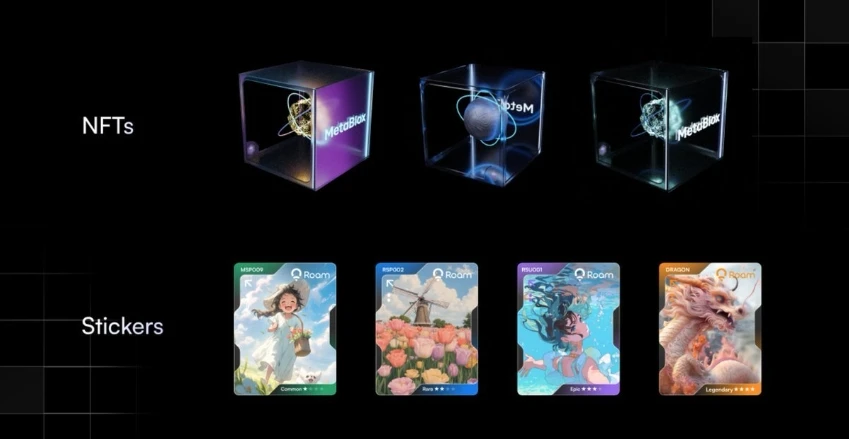
3.0 Points Burning
Starting from January 24, 2025, Roam initiated the pre-burning of points, which exceeded the team's expectations and provided valuable data for the improvement of the economic system.
The burning mechanism is divided into three burning pools: the mining machine pool, the sticker pool, and the general pool. The proportion of tokens generated by each pool is 5:3:2.
In these pools, the mining machine pool is dedicated to burning points generated by mining machines. For example, if a user has 1 million points, of which 100,000 points come from mining machines and the remaining 900,000 points come from community mining and check-in activities, then the user has a burning quota of only 100,000 points in the mining machine pool.
The burning mechanism of the sticker pool requires users to use stickers to build their burning quota. Roam provides four types of stickers: ordinary stickers (burnable for 50 points), rare stickers (burnable for 100 points), uncommon stickers (burnable for 250 points), and legendary stickers (burnable for 1000 points). A maximum of 50 stickers can be used at the same time, but it should be noted that stickers can only be used once.
The remaining points are burned in the general pool.
Within each cycle, the number of tokens obtained per point burned entirely depends on the total number of points participating in the burn during that cycle. If a point pool can generate 648 tokens in a cycle and 10,000 points participate in the burn, then each point can obtain 0.0648 tokens.
After 1,930 cycles, the burning results are as follows:
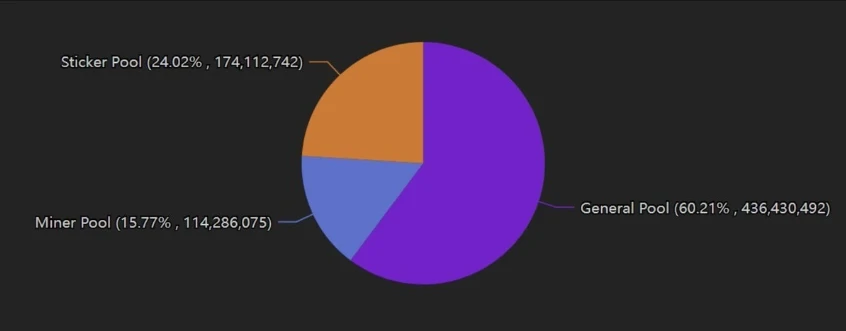
In just over ten days, Roam has burned a quarter of the points generated in the past year and a half. The popularity of the entire burning process is evident: after the first few cycles, the number of people participating in the burn online at any time stabilized at over ten thousand.
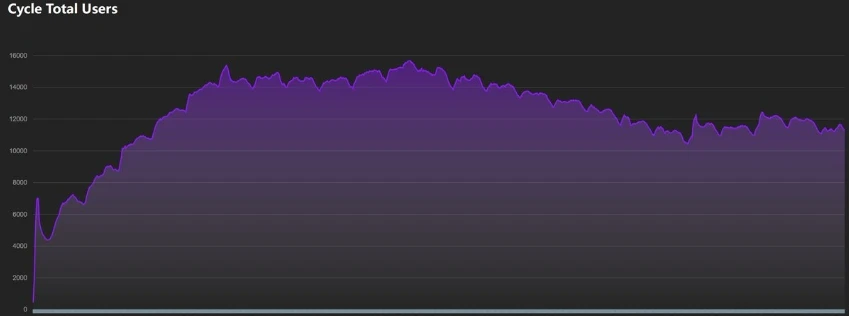
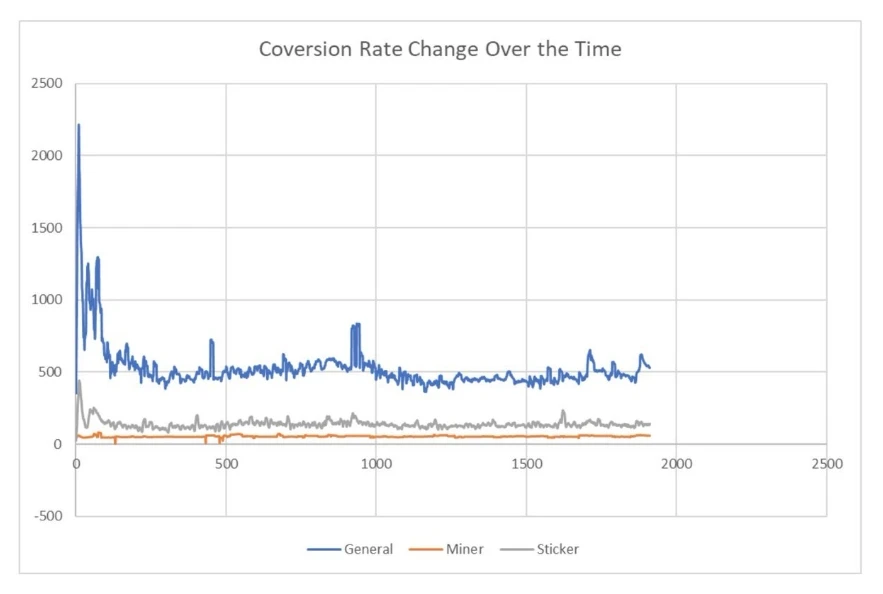
The average conversion rate for the mining machine pool is 54.5 points to one token, for the sticker pool it is 139.1 points, and for the general pool, it is 523.3 points. The high conversion rate of the mining machine pool ensures stable earnings for mining machines. The relatively high conversion rate of the sticker pool further rewards users who check in more frequently.
4.0 Value Support for Roam Tokens and Points
The ultimate success of an economic system often stems from the stability and growth of token prices. So, what supports the value of Roam tokens? The answer lies in two main aspects: the intrinsic value increase brought about by the expansion of network scale and the appreciation of individual token value due to the token deflation mechanism.
4.1 Increase in Intrinsic Value:
The growth of the Roam network scale has been fully demonstrated through data from Roam Explorer - Real-Time Updates on Roam Network’s Expansion, so there is no need to elaborate further.
4.2 Token Consumption and Deflation Mechanism:
4.2.1 Absolute Deflation: Token Burning and Disappearance
Tokens achieve permanent exit from circulation through the burning mechanism, directly reducing the total amount in circulation and enhancing the value of individual tokens.
4.2.1.1 Arbitrage-Driven Token Reverse Conversion to Points
After TGE, Roam will initiate the reverse conversion mechanism. Users can convert tokens to points using the weighted average values of the sticker pool and general pool within any cycle. Assuming an average value based on the past 1,900 cycles, one token can be converted to 292.78 points. The converted tokens will be burned and exit circulation.
This process provides arbitrage opportunities for users with enough stickers, incentivizing them to convert one token to points and then earn more tokens through re-burning. (Currently, 139.1 points in the sticker pool convert to one token)
The reason the burning quantity in the points pool is much smaller than that in the general pool is that the number of stickers is the bottleneck for burning, and stickers can only be obtained through the core behavior of check-ins.
Although this process may lower the conversion rate of the sticker pool, since the number of stickers, not the number of points, is the burning bottleneck, generating more points after token reverse conversion will not change the situation of the sticker pool's higher conversion rate; it will still help promote token burning.
This mechanism will greatly stimulate further interaction between users and the app, amplifying the value of data, advertising, and traffic, thereby stimulating more cash income.
4.2.1.2 Points Application Drives Token Reverse Conversion
All applications within the Roam ecosystem, including games, social, AI, etc., require the consumption of points. Whether in the popular BitBang game in the Indonesian community or MojoGogo AI managing Twitter, various AI assistants, accelerating synthesis cards, trading market for buying stickers, and the badge system, points are indispensable. If points are insufficient and one does not want to earn them through mining, then purchasing tokens to burn points becomes the only option.
4.2.1.3 Direct Token Burning
Currently, the Roam ecosystem has generated 3 billion points, of which over 1 billion points have been burned. This includes 700 million points consumed in pre-burning and 300 million points recovered and burned through Roam's own network income. After TGE, Roam can also choose to use part of its income to directly purchase tokens on the market and burn them, further reducing the amount of tokens in circulation.
4.2.2 Relative Deflation: Imbalance of Token Supply and Demand
In the market, when the demand for tokens exceeds the supply, the price of tokens typically rises.
4.2.2.1 Metcalfe's Law and Exponential Decay Token Release Curve
As a typical network connecting people, Roam's value is proportional to the square of the number of network nodes, which reflects Metcalfe's Law. However, Roam's token release curve is similar to Bitcoin's, exhibiting exponential decay. As the number of network participants and nodes increases, the growth of token supply lags behind the growth of demand, resulting in an inherent mismatch that increases token value.
4.2.2.2 Increased Demand from Expanded Token Use Cases
Even if the number of tokens remains unchanged, an increase in token use cases will also lead to deflation. Suppose 100 tokens could initially be used in two scenarios; when the number of use cases increases to ten, the number of tokens available for each scenario will significantly decrease. If the circulation speed of tokens cannot be increased, deflation will occur. After Roam's TGE, tokens can be used in various scenarios outside the ecosystem. For example, tokens can be used to recharge credit cards for consumption, exchange for other tokens in Discovery projects, purchase phone numbers, and eSIM data, etc. Each additional use case effectively triggers deflation.
4.2.2.3 Reducing Token Circulation Speed
Reducing the circulation speed of tokens will also create a deflationary effect. By locking Roam tokens to obtain free internet access, participating in staking pools, etc., the number of tokens circulating in the market can be effectively reduced, thereby enhancing token value.
4.2.3 Summary
Through these mechanisms, Roam not only maintains the relative scarcity of tokens but also increases the demand for tokens in diverse application scenarios, thereby promoting the healthy development of the overall economic system. This relative deflation strategy helps ensure the long-term value of Roam tokens.
4.3 Roam Points
Roam points circulate only within the system, making it easier to establish their relatively stable value. After the pre-burning phase, we found that despite the total amount being unlimited, it has entered a slight deflationary state. In this case, we only need to adjust the speed of point generation to ensure the constancy of its value.
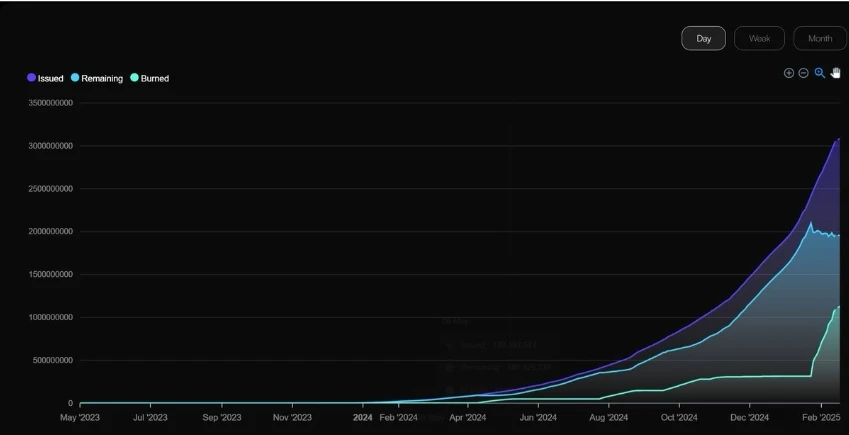
5.0 Roam's Airdrop Strategy
For many projects without actual products, on-chain interaction airdrops are often a technical trading behavior on exchanges. Such airdrops cannot retain users because they quickly sell off the tokens received, leading to increased selling pressure on the tokens. Therefore, many project teams often secretly reduce the actual number of tokens allocated during distribution, which has also sparked many controversies regarding insider trading networks.
However, for Roam, airdrops are a more cost-effective customer acquisition channel compared to traditional methods like SEO and SMM, competing with Web2 eSIM and WiFi providers. Roam not only airdrops tokens but also airdrops traffic! Roam's airdrop activities are conducted within the app, specifically targeting valuable users and new users, ensuring that there is no waste of resources. This strategy not only improves the quality of users but also maintains a harmonious atmosphere in the Roam community.
Through this precisely targeted airdrop approach, Roam can effectively attract and retain truly valuable users, laying the foundation for the long-term development of the product.
6.0 If a Bear Market Comes…
In a bear market environment, token prices are usually under pressure, and market liquidity may be lacking. However, Roam's economic system has multiple pathways to respond to this challenge and maintain the stability of token value.
Path One: Difficulty Adjustment and Accelerated Deflation
In the case of reduced participation and decreased network activity, Roam's difficulty adjustment mechanism will be activated, leading to a decrease in the speed of token generation. This accelerates the deflation process, providing support for token prices.
Path Two: Token/Point Arbitrage Accelerates Burning
As network activity decreases, the number of stickers will also decline, thereby reducing the difficulty of arbitrage. With increased arbitrage activities, the speed of token burning accelerates, thus supporting token prices.
Path Three: Token Accumulation and Stable Income
Users can earn APY by staking tokens or obtain free communication services through locking. This reduces the circulation speed of tokens, creating relative deflation, which in turn supports token prices.
Path Four: Bear Market Favors Low-Cost Services
Bear markets often drive more users to seek low-cost services, which may lead to more users switching from traditional operators to Roam. This shift not only enhances Roam's profits but also provides possibilities for token repurchase and destruction or treasury replenishment, further supporting token prices.
Through these pathways, Roam can not only maintain its stability during a bear market but also ensure the value growth of tokens in the long-term development by optimizing economic mechanisms. Roam is also actively exploring more pathways to face future challenges regarding token prices and liquidity.
7.0 Conclusion
Crypto has reached a turning point; for teams accustomed to past business models, this is nothing short of hell. However, I believe for teams that have been deeply involved in the web2 internet space for a long time, this is truly a paradise.
免责声明:本文章仅代表作者个人观点,不代表本平台的立场和观点。本文章仅供信息分享,不构成对任何人的任何投资建议。用户与作者之间的任何争议,与本平台无关。如网页中刊载的文章或图片涉及侵权,请提供相关的权利证明和身份证明发送邮件到support@aicoin.com,本平台相关工作人员将会进行核查。




